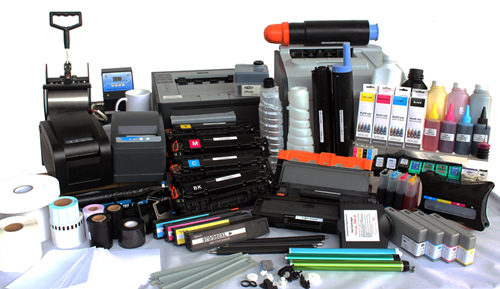Overview Printing Consumable Industry


The Future of Global Print Equipment Markets to 2022 examines the changing nature of equipment manufacturers, the transition from analogue to digital.
Over the next five years, expenditure is forecast to grow slowly. Despite continuing growth in emerging markets and investments in packaging printing machinery, this is offset by declining demand for traditional print on paper and adverse conditions in mature economies.
At the same time, digital printing equipment continues to make inroads in areas previously dominated by analogue print, opening up new value-added opportunities for equipment suppliers and printers alike. As demand for new printing equipment changes, so is the business model of printers, increasingly looking to build up new/niche areas of strength, facilitated by judicious investment in the latest machinery.
With the development of technologgy, rising requirements for higher value digital production – to print low runs and to add engagement to the printed item – and for packaging where the physical needs and heavier substrates are higher in price.”
Packaging and labels are growing consistently, while publication print volumes and value are declining significantly. In publication and commercial graphics, electronic media is steadily replacing printed products. Print manufacturers are also more efficient, using better workflow and automation to minimize make-ready and lower waste, reducing demand for paper and inks.
There are similar efficiencies in packaging, but digital enjoys very low share (except for labels) and overall demand is growing. As digital systems develop there will be supply chain efficiencies reducing waste and unused packaging in those sectors. Digital print, chiefly used in the commercial print sector and labels, is faring rather better than the long-established analogue alternatives and is forecast to increase in market share by 2022 as new applications, particularly in packaging, grow. It is the higher value that is attractive to print service providers and to equipment and consumable manufacturers.
There are declines in North America, Western Europe and Australasia, while Latin America, the Middle East, Eastern Europe and Africa all see growth. Asia is the biggest print region, growing in volume and value. China continues to grow and has overtaken the volume in the US during 2015 to become the biggest print market, although the value of the output is significantly lower reflecting the different product mix and lower pricing.
Analogue machinery is expected to fall while the value of digital equipment more than doubles in real terms. Printing inks and coating use broadly follows print volumes, although there are market mix changes with increasing use of colour, more radiation curing and greater use of varnishes and coatings pushing growth. It is, however, the much higher valued digital grades that are showing growth.
 The Future of Global Printing to 2022 examines the changing nature of global print and the varying prospects for the different product sectors, print processes and regional markets over the next five years, with comprehensive market data and industry analysis based on new primary research.
The Future of Global Printing to 2022 examines the changing nature of global print and the varying prospects for the different product sectors, print processes and regional markets over the next five years, with comprehensive market data and industry analysis based on new primary research.
Over the next five years, expenditure is forecast to grow slowly. Despite continuing growth in emerging markets and investments in packaging printing machinery, this is offset by declining demand for traditional print on paper and adverse conditions in mature economies.
At the same time, digital printing equipment continues to make inroads in areas previously dominated by analogue print, opening up new value-added opportunities for equipment suppliers and printers alike. As demand for new printing equipment changes, so is the business model of printers, increasingly looking to build up new/niche areas of strength, facilitated by judicious investment in the latest machinery.
With the development of technologgy, rising requirements for higher value digital production – to print low runs and to add engagement to the printed item – and for packaging where the physical needs and heavier substrates are higher in price.”
Packaging and labels are growing consistently, while publication print volumes and value are declining significantly. In publication and commercial graphics, electronic media is steadily replacing printed products. Print manufacturers are also more efficient, using better workflow and automation to minimize make-ready and lower waste, reducing demand for paper and inks.
There are similar efficiencies in packaging, but digital enjoys very low share (except for labels) and overall demand is growing. As digital systems develop there will be supply chain efficiencies reducing waste and unused packaging in those sectors. Digital print, chiefly used in the commercial print sector and labels, is faring rather better than the long-established analogue alternatives and is forecast to increase in market share by 2022 as new applications, particularly in packaging, grow. It is the higher value that is attractive to print service providers and to equipment and consumable manufacturers.
There are declines in North America, Western Europe and Australasia, while Latin America, the Middle East, Eastern Europe and Africa all see growth. Asia is the biggest print region, growing in volume and value. China continues to grow and has overtaken the volume in the US during 2015 to become the biggest print market, although the value of the output is significantly lower reflecting the different product mix and lower pricing.
Analogue machinery is expected to fall while the value of digital equipment more than doubles in real terms. Printing inks and coating use broadly follows print volumes, although there are market mix changes with increasing use of colour, more radiation curing and greater use of varnishes and coatings pushing growth. It is, however, the much higher valued digital grades that are showing growth.
 The Future of Global Printing to 2022 examines the changing nature of global print and the varying prospects for the different product sectors, print processes and regional markets over the next five years, with comprehensive market data and industry analysis based on new primary research.
The Future of Global Printing to 2022 examines the changing nature of global print and the varying prospects for the different product sectors, print processes and regional markets over the next five years, with comprehensive market data and industry analysis based on new primary research. EUR
EUR GBP
GBP CNY
CNY

